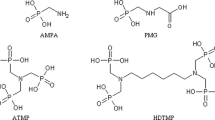Abstract
Cells of the yeast strain Debaryomyces vanrijiae SBUG 770, grown with glucose, converted biphenyl to 4-hydroxybiphenyl as the major metabolite. In addition, 2-hydroxybiphenyl was formed in minor amounts. No further degradation of these substances was detected. However, these monohydroxylated derivatives were oxidised by alkane-grown cells in the presence of the co-metabolic substrate, tetradecane. Under these conditions 2-hydroxybiphenyl was oxidised to 2,5-dihydroxybiphenyl, and 4-hydroxybiphenyl was rapidly metabolised by formation of two major metabolites. One was identified as 3,4-dihydroxybiphenyl. Characterisation of the second product as 4-phenylmuconolactone points to a further metabolism of the initially formed dihydroxylated biphenyl via ortho-ring fission.
Similar content being viewed by others
Author information
Authors and Affiliations
Additional information
Received: 8 May 1998 / Received revision: 26 June 1998 / Accepted: 2 July 1998
Rights and permissions
About this article
Cite this article
Lange, J., Hammer, E., Specht, M. et al. Biodegradation of biphenyl by the ascomycetous yeast Debaryomyces vanrijiae . Appl Microbiol Biotechnol 50, 364–368 (1998). https://doi.org/10.1007/s002530051305
Issue Date:
DOI: https://doi.org/10.1007/s002530051305




